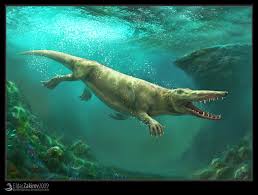Meet Ambulocetus (meaning “walking whale”), an ancestor of today’s whales and dolphins, who lived in the early Eocene Epoch some 50 – 49 million years ago. He was approximately the size of modern sea lions. Along with other members of his family – Ambulocetidae – paleontologists believe he was a transitional species that shows how whales evolved from land-dwelling mammals. Interestingly, we gave him his name at a time that we believed he was capable of walking on land, but now our most current research suggests that he was fully aquatic, like today’s cetaceans.
Ambulocetus probably swam by undulating his back vertically, with his swimming aided by short limbs and large feet. Chemical analysis of his teeth shows that he could move between salt and fresh water. He shared several features with other basal cetaceans, such as an adaptation in the nose that let him swallow underwater, a lack of external ears, and a periotic bone structure (i.e. pertaining to certain bones or bony elements that help to form a protective capsule for the internal ear) much like those of whales, which would have enabled him to hear well underwater.
He probably fed in a way that was very similar to larger crocodilians, with a long snout, strong muscles in the jaw, and pointed teeth designed to grab and hold his victims. Like crocodiles, he probably killed his prey by either drowning it or thrashing it with violent motions. He was probably an ambush predator that fed on larger fish, aquatic tetrapods (four-limbed animals) and terrestrial animals who ventured near the water. His teeth suggest he probably chewed his food somewhat (which crocodiles don’t do), but probably did minimal food processing in the mouth.
The comparison with this class of animals is striking when we consider the widely divergent paths followed by evolution in these two cases. Whereas crocodiles represent a hugely successful ‘design’ that’s remained relatively unchanged for more than 80 million years, the extraordinary journey of cetaceans from the land back to the sea has seen them undergo dramatic changes. Incredibly, their early ancestors were terrestrial artiodactyls, similar to small deer – the raoellids. The first animals we might call cetaceans were amphibious, and would have originated somewhere around 50 million years ago. A series of intermediate fossils – including ambulocetus – documents the transition from land to water, ending with the obligate aquatic mammals we know today.
Today there are about 90 species of cetaceans. Though all have a similar body shape – with streamlined bodies, flippers as forelimbs, no external hind limbs, and a horizontal tail fluke – the variation in body size is enormous. Contrast the vaquita’s 1.5 meter length and 40 kgs to the blue whale’s 27 meters and nearly 140,000 kgs!
Cetaceans are not closely related to other marine mammals. Sirenians (manatees and dugongs) are most closely related to elephants, while pinnipeds (seals, sea lions, walruses) are related to land carnivores, especially to the dog and bear families. This is despite many features cetaceans, sirenians and pinnipeds have in common – an evolutionary response to the needs of their environment.
Even in Darwin’s time, it was known that cetaceans had land ancestors, but cetaceans are so different from land mammals that it was difficult to identify similarities in anatomy. It wasn’t until the 1990s that the first in a series of fossils were discovered, mostly in Pakistan and India, that helped provide a more complete documentation of the transition from land to water. As with so many other cases, molecular biology also came to play a key role in identifying genetic similarities between cetaceans and artiodactyls that are missing in other mammals. Modern artiodactyls include pigs, camels, deer, sheep, cattle, and hippos, with the latter now thought to be the cetaceans’ closest living relatives.
So in case you’re wondering, if that’s the dolphin’s closest land-based relative, can they really be as smart as we think they are? Well, funny you should ask. Humans, as you know, belong to an order of mammals known as primates. It’s still hotly debated among scientists, with molecular biology again coming to the rescue, but primates’ closest living relatives are either the colugos of Order Dermoptera, generally known as “flying lemurs” (though they are neither lemurs nor capable of flight), or the Scandentians. So say hello to your closest kin, our friend the tree-shrew.
For The Orca’s Voice,
Phil, Canadian Cetacean Alliance



Leave a Reply